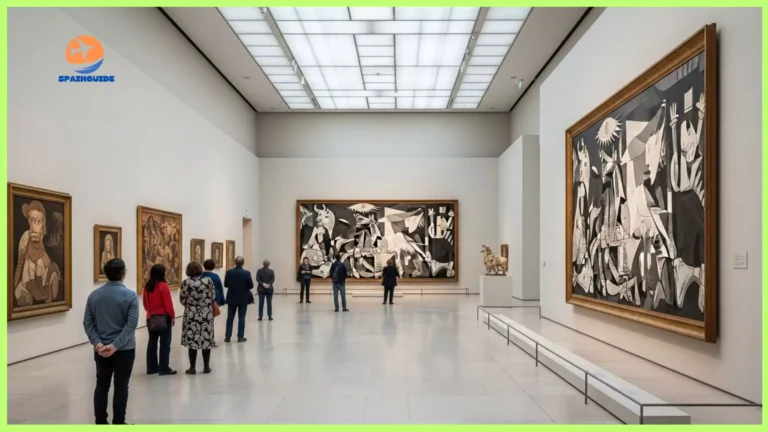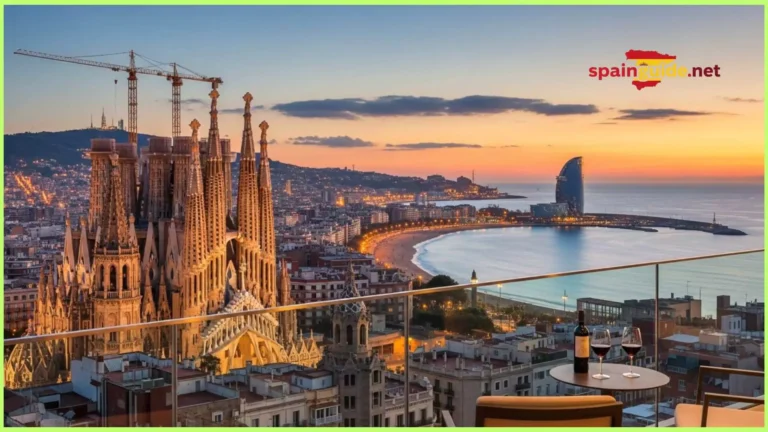Spain’s basically the ultimate playground for art and history nerds, and honestly, even if you think museums are boring, this country will completely change your mind. We’re talking about the birthplace of Picasso, Dalí, Velázquez, and Goya – plus centuries of Roman ruins, stunning Moorish architecture, and cultural treasures that’ll make your Instagram followers seriously jealous.
Whether you’re someone who can spend hours getting lost in art galleries or you’re more of a “quick look and move on” type, Spain’s museums offer experiences you literally can’t get anywhere else. Trust me, places like the Guggenheim Bilbao and the Prado aren’t just tourist traps – they’re genuine game-changers that’ll have you seeing art in a whole new way.
Why Visit Museums in Spain?
Here’s the thing about Spain’s artistic legacy – it’s absolutely mind-blowing. We’re talking about a timeline that goes from 40,000-year-old cave paintings (yeah, seriously) all the way to cutting-edge contemporary art. Spain’s been the crossroads of civilizations for millennia, and every single cultural exchange left its mark.
The Romans brought engineering and mosaics, the Moors introduced incredible geometric art and architecture, the Catholic Kings commissioned religious masterpieces, and then Spanish artists basically invented modern art as we know it. Picasso alone changed how we see the world, but he was just one of many Spanish artists who revolutionized everything.
But here’s what I love about Spanish museums – they don’t just show you pretty pictures behind glass. They tell stories. The Prado lets you walk through Spanish royal history, the Reina Sofía shows how artists responded to war and dictatorship, and places like the Alhambra Museum help you understand how Islamic culture shaped Spanish identity. You’re not just looking at art; you’re getting a crash course in European civilization.
Top Art Museums in Spain
Prado Museum – Madrid
The Prado isn’t just Madrid’s most famous museum – it’s basically Spain’s artistic soul on full display. This place houses the world’s best collection of Spanish painting, and walking through feels like getting VIP access to European art history.
The absolute must-sees: Velázquez’s “Las Meninas” will mess with your head in the best way (it’s this incredibly complex painting about painting), Goya’s haunting “Black Paintings” that he created during his darkest period, and El Greco’s mystical portraits that seem to glow from within. The royal collections here are insane because Spanish kings had unlimited budgets and seriously good taste.
Visiting smart: Go first thing in the morning (8 AM opening) or late afternoon to dodge the worst crowds. There’s free entry during the last two hours on weekdays and Sunday evenings, but expect lines. Buy tickets online during peak tourist season – trust me on this one.
Museo Reina Sofía – Madrid
This is where Spanish art gets political, modern, and absolutely fascinating. The Reina Sofía specializes in 20th-century art, and it’s essential for understanding how Spanish artists dealt with war, dictatorship, and massive social changes.
Guernica alert: Picasso’s “Guernica” alone makes this museum worth visiting. It’s this massive anti-war masterpiece that hits you like an emotional sledgehammer. But don’t sleep on the incredible works by Miró, Dalí, and other Spanish surrealists who basically turned art upside down and inside out.
Money-saving tip: Free admission Saturday afternoons and Sunday mornings, though it gets pretty packed. Weekday mornings are perfect if you want breathing room with the masterpieces.
Guggenheim Museum – Bilbao
Frank Gehry’s titanium masterpiece literally transformed Bilbao from forgotten industrial city to must-visit art destination overnight. Honestly, the building itself might be more famous than what’s inside, though the art collection is incredible too.
The curved, shimmering exterior looks completely different from every angle, and inside, the dramatic spaces make every artwork feel more important and impactful. The focus is contemporary art, with rotating exhibitions that consistently blow minds and challenge expectations.
Don’t miss: Louise Bourgeois’ giant spider “Maman” outside is Instagram gold, and whatever major exhibition is running – the Guggenheim always lands the blockbuster international shows.
Thyssen-Bornemisza Museum – Madrid
The Thyssen’s got the most wonderfully eclectic collection you’ll find anywhere – literally everything from medieval religious paintings to Andy Warhol pop art. The Thyssen family spent decades collecting whatever caught their fancy, and the result is this amazing survey of Western art history.
What makes it special: You can trace artistic movements chronologically, seeing how styles evolved and influenced each other across centuries. Plus, it fills in gaps that the Prado and Reina Sofía don’t cover, completing Madrid’s incredible “Golden Triangle” of art museums.
Picasso Museums – Barcelona & Málaga
Barcelona’s Picasso Museum focuses on his formative years and Blue Period, showing how the world’s most revolutionary artist developed his groundbreaking style. Málaga (his actual birthplace) covers his entire career with more personal context and family history.
Barcelona highlight: The “Las Meninas” series, where Picasso reimagines Velázquez’s famous painting in his own cubist style – it’s absolutely mind-bending to see how he deconstructed and rebuilt such an iconic image.
Must-Visit History Museums in Spain
National Archaeological Museum – Madrid
This place tells Spain’s entire story from the very beginning. We’re talking ancient Iberian sculptures, incredible Roman mosaics, Visigothic treasures, and Moorish artifacts that show how different cultures layered on top of each other to create Spanish identity.
Star attraction: The replica of Altamira cave paintings – since the real caves are closed to protect them, this is your only chance to see humanity’s earliest masterpieces up close.
Museum of the History of Catalonia – Barcelona
Perfect for understanding why Catalonia feels so distinct from the rest of Spain. The interactive exhibits make medieval trade routes and industrial revolutions actually engaging, and you’ll leave totally getting why Catalans are so fiercely proud of their unique culture.
Roman Theatre Museum – Cartagena
This is archaeology done absolutely right – they built the entire museum around actual Roman ruins, so you’re literally walking through 2,000-year-old streets and seeing how Romans actually lived, worked, and entertained themselves.
Alhambra Museum – Granada
Essential for understanding Islamic Spain’s incredible artistic legacy. The museum sits right within the Alhambra complex, so you can see artifacts and then step outside to experience the architectural masterpieces they came from.
Regional Gems Worth Exploring
Salvador Dalí Theatre-Museum – Figueres: Dalí designed his own museum, and it’s as wonderfully bizarre as you’d expect. His tomb is here, along with surreal installations that’ll mess with your perception of reality.
Valencia’s City of Arts and Sciences: Ultra-modern architecture housing multiple museums focused on science, oceanography, and interactive learning. It’s like visiting the future.
Seville’s Museum of Fine Arts: Totally underrated but absolutely incredible, especially for Spanish Golden Age painting. Way fewer crowds than Madrid’s big museums, with some genuine jaw-dropping masterpieces.
Practical Travel Tips
Perfect timing: Spring and fall are ideal for museum hopping – comfortable weather for walking between attractions, and you won’t be fighting peak summer tourist crowds for gallery space.
Money-saving strategies: Many museums offer free entry hours (usually evenings or Sunday mornings). Madrid’s “Golden Triangle” pass covers the Prado, Reina Sofía, and Thyssen-Bornemisza at a discount. Always book online to skip entrance lines during busy periods.
Smart planning: Don’t try cramming six museums into one day – museum fatigue is totally real. Better to really enjoy 2-3 places than rush through everything. Break up cultural overload with great local restaurants, parks, or coffee breaks.
Your Spanish Museum Adventure
Spain’s museums aren’t just places to look at old stuff – they’re gateways into understanding one of the world’s most fascinating and influential cultures. From prehistoric cave art to Picasso’s revolutionary breakthroughs, from Roman engineering marvels to Islamic geometric perfection, these collections showcase human creativity at its absolute finest.
The best part? You don’t need an art degree to be moved by Goya’s intense portraits or amazed by intricate Moorish craftsmanship. These museums are designed to inspire, educate, and occasionally blow your mind with the sheer audacity of human imagination and artistic vision.
Whether you’re planning an intensive Madrid art marathon, exploring Catalonia’s distinct cultural identity, or just want to understand how Spanish artists literally changed the world, these museums deliver unforgettable experiences you’ll be talking about for years.
FAQ
Should I book museum tickets in advance?
Definitely yes for major museums like the Prado and Guggenheim during peak season (summer/holidays). Smaller museums usually allow walk-ins, but check websites for special exhibitions that might sell out.
How long should I spend in each museum?
Plan 2-3 hours for major museums like the Prado or Guggenheim. Smaller specialized museums might only need 60-90 minutes. Focus on highlights rather than trying to see absolutely everything.
Are Spanish museums expensive?
Pretty reasonable by European standards. Major museums typically cost €10-15, but many offer free entry hours. City museum passes can save significant money if you’re visiting multiple attractions.
What’s the best order for Madrid’s famous art triangle?
Start chronologically: Prado for classical and Spanish masters, then Thyssen-Bornemisza for the evolution through different periods, and finish with Reina Sofía for modern/contemporary art. This creates a logical artistic journey through time.
Do I need to speak Spanish to enjoy the museums?
Not at all! Major museums have English audio guides, apps, and information. Learning basic Spanish art terms enhances the experience, but language won’t be a barrier to enjoying world-class art and history.
So which museum’s got you most excited? Whatever you choose, you’re in for some seriously mind-expanding cultural experiences that’ll probably have you planning your next Spanish museum adventure before you even leave the first one!







